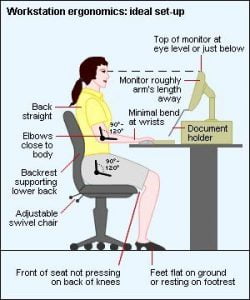
A lot of us are working from home these days, and plenty of us have more aches and pains than usual. No wonder. We are hunched over our laptops in the recliner, lying on the sofa or trying to work at the kitchen table. How do you keep working at home from getting too physically painful How do you avoid neck strain, hip pain, backaches and shoulder troubles?
The first thing we heard from the experts was to move.
Our bodies are not meant to be still. Get up and move around (every hour or so). Five minutes of getting up and stretching and moving around will make a tremendous difference.
Get up, go outside, go for a walk. We are too trapped in the office environment, where people sit all day at work and then go home and sit more.
A recent study showed that within 15 hours of not moving, you begin to show muscle atrophy. If we don’t use it, our body doesn’t take care of itself.
And don’t assume using a standing desk is any better. Whether you are sitting or standing, you’ve got to keep moving.
When you walk, take large strides. It opens up your hips.
Here are some other things to keep in mind as you work from home.
Don’t work from a soft spot.
Stay out of the recliner or lying in bed. Sofas aren’t any good either.
Soft furniture is a big problem. It affects everything from your neck down.
Don’t hunch over.
Any time you are putting your laptop in your lap, it forces you to look down.
Your head weighs 10 to 15 pounds, and when you put pressure on your neck, you are looking at (up to) 60 pounds of pressure.
A recent study published by Surgery Technology International shows that the more you lean your neck forward, the heavier the pressure gets. At a 60-degree angle, your head puts 60 pounds of strain on your neck.
Move your head back, look up, raise shoulders, straighten your elbows.
You shouldn’t have to be craning your neck. The sweet spot is to hold out your hand and the middle finger should be able to touch the screen. If you have the internet open, your sight should be right at the address bar.
You can raise the laptop by putting a few books under it, but do not make it so high your arms have to reach up.
And if you have access to a desktop, use it. It makes it easier to not hunch over.
Keep your feet on the ground.
Do not cross your legs, don’t sit on your foot, don’t dangle a leg. You can start affecting the pelvis,
You are putting pressure on the hips and, over time, you can pull out of alignment. It is cutting out blood supply to our feet. The blood has to be able to flow. You may have to use a foot rest.
Sit up straight.
You should have square shoulders. It helps with breathing. Stay away from hunching forward.
Here are the basics for sitting:
Put your buttocks against the back of the chair and arch your lower back slightly. Lumbar support, such as a small pillow or a rolled up towel, can be placed against the arch.
Without that support, the body tends to move forward into a hunchback position.
0800 473 776
